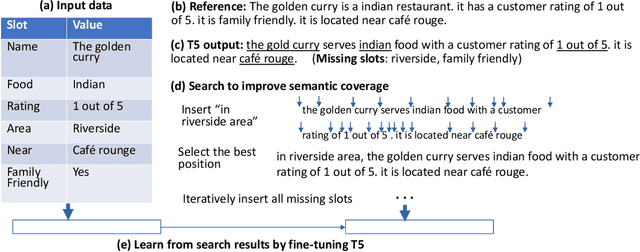Zi Xuan Zhang
Search and Learn: Improving Semantic Coverage for Data-to-Text Generation
Dec 06, 2021



Abstract:Data-to-text generation systems aim to generate text descriptions based on input data (often represented in the tabular form). A typical system uses huge training samples for learning the correspondence between tables and texts. However, large training sets are expensive to obtain, limiting the applicability of these approaches in real-world scenarios. In this work, we focus on few-shot data-to-text generation. We observe that, while fine-tuned pretrained language models may generate plausible sentences, they suffer from the low semantic coverage problem in the few-shot setting. In other words, important input slots tend to be missing in the generated text. To this end, we propose a search-and-learning approach that leverages pretrained language models but inserts the missing slots to improve the semantic coverage. We further fine-tune our system based on the search results to smooth out the search noise, yielding better-quality text and improving inference efficiency to a large extent. Experiments show that our model achieves high performance on E2E and WikiBio datasets. Especially, we cover 98.35% of input slots on E2E, largely alleviating the low coverage problem.
Weakly Supervised Explainable Phrasal Reasoning with Neural Fuzzy Logic
Sep 18, 2021



Abstract:Natural language inference (NLI) aims to determine the logical relationship between two sentences among the target labels Entailment, Contradiction, and Neutral. In recent years, deep learning models have become a prevailing approach to NLI, but they lack interpretability and explainability. In this work, we address the explainability for NLI by weakly supervised logical reasoning, and propose an Explainable Phrasal Reasoning (EPR) approach. Our model first detects phrases as the semantic unit and aligns corresponding phrases. Then, the model predicts the NLI label for the aligned phrases, and induces the sentence label by fuzzy logic formulas. Our EPR is almost everywhere differentiable and thus the system can be trained end-to-end in a weakly supervised manner. We annotated a corpus and developed a set of metrics to evaluate phrasal reasoning. Results show that our EPR yields much more meaningful explanations in terms of F scores than previous studies. To the best of our knowledge, we are the first to develop a weakly supervised phrasal reasoning model for the NLI task.
 Add to Chrome
Add to Chrome Add to Firefox
Add to Firefox Add to Edge
Add to Edge